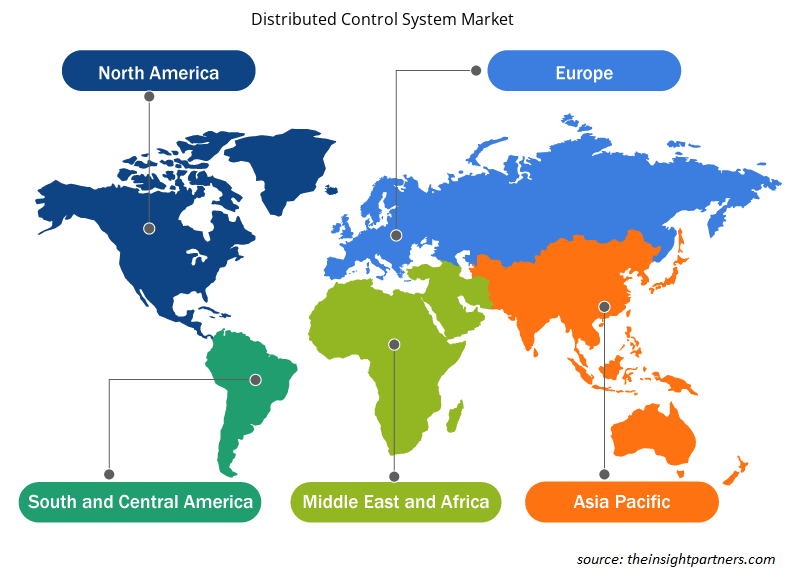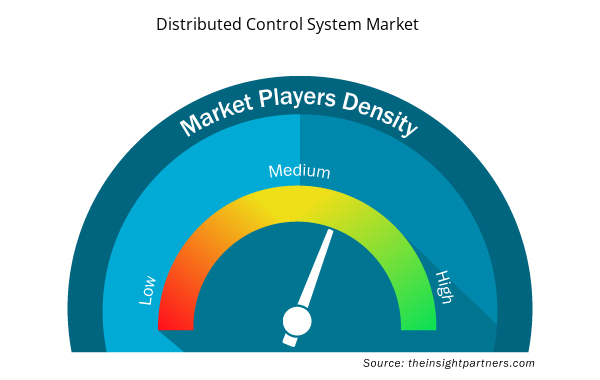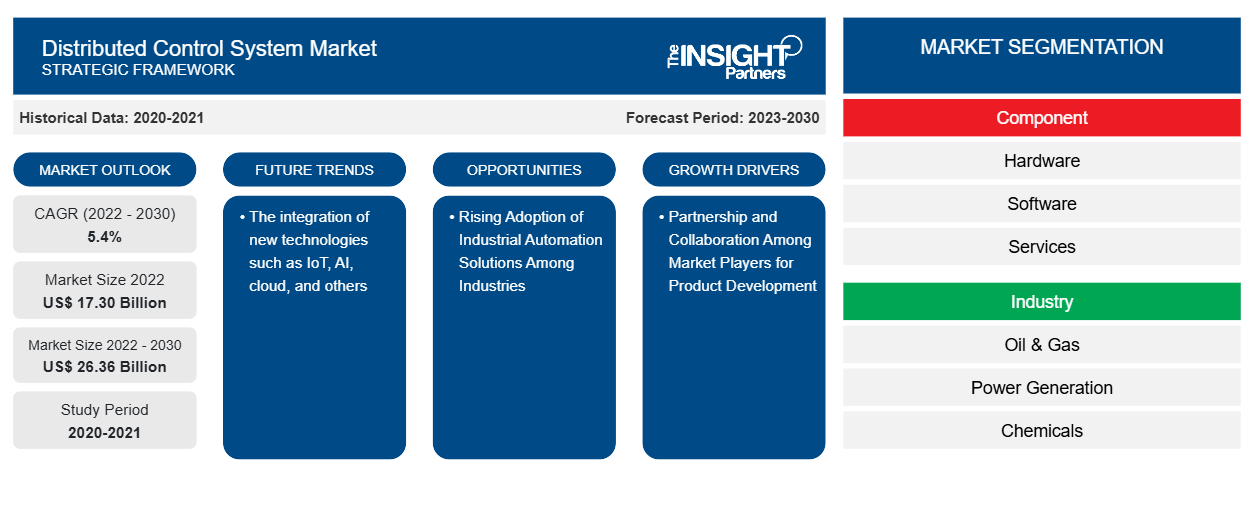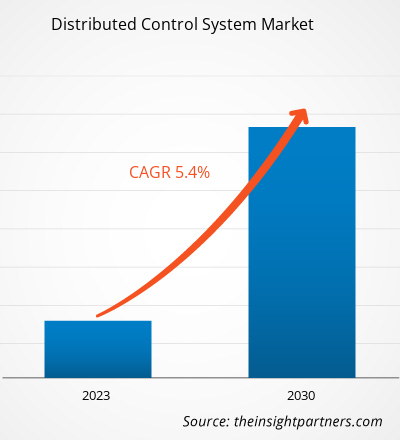分散制御システムの市場規模は、2022年の173億米ドルから2030年には263億6000万米ドルに達すると予測されています。市場は2022年から2030年の間に5.4%のCAGRを記録すると予想されています。IoT 、 AI、クラウドなどの新技術の統合は、市場の主要なトレンドであり続けると思われます。
分散制御システム市場分析
業界における産業オートメーション ソリューションの採用の増加と、電力およびエネルギー部門の成長が市場を牽引しています。市場は、新しい製造施設の建設により、予測期間中に成長すると予想されます。さらに、DCSの製品開発とアーキテクチャ開発に関する市場プレーヤー間のパートナーシップとコラボレーションにより、市場に有利な機会が生まれています。
分散制御システム市場の概要
分散制御システム ( DCS ) は、工場全体に分散されたセンサー、コントローラ、および関連コンピュータで構成されるコンピュータ化されたシステムです。これらの各部分は、データ取得、プロセス制御、データ保存、グラフィック表示などの特定の機能を果たします。これらのさまざまな部分は、制御ネットワークとも呼ばれる工場のローカル エリア ネットワーク (LAN) を介して中央コンピュータと通信します。
DCSは、連続プロセスおよびバッチ プロセスで使用される産業機器を自動化し、人や環境へのリスクを軽減します。このシステムは、採掘、化学製造プラント、輸送および処理、発電、水および廃水処理、医薬品処理施設など、さまざまな業界で使用されています。
要件に合わせてレポートをカスタマイズする
このレポートの一部、国レベルの分析、Excelデータパックなど、あらゆるレポートを無料でカスタマイズできます。また、スタートアップや大学向けのお得なオファーや割引もご利用いただけます。
- このレポートの主要な市場動向を入手してください。この無料サンプルには、市場動向から見積もりや予測に至るまでのデータ分析が含まれます。
分散制御システム市場の推進要因と機会
産業オートメーションソリューションの採用が業界間で増加し、市場を後押し
産業オートメーションは、ハードウェアとコンポーネントを使用して、産業または製造環境でシステムを自動化することと広く定義されています。企業は、産業オートメーションの採用を促進するためにさまざまなプログラムを立ち上げています。たとえば、2023年9月、ロックウェル・オートメーションはBICと協力して、Plex製造実行システム(MES)を使用してデジタル変革と効率化を推進しました。企業によるこのような取り組みは、分散制御システム市場の成長を牽引するでしょう。さらに、石油・ガス、石油化学、製薬業界は急速に拡大しています。これらの産業分野では、技術的に高度な企業の存在と、研究開発業務への政府支出の増加により、技術の進歩も進んでいます。
製品開発における市場プレーヤー間のパートナーシップとコラボレーション
世界中で多くの分野が劇的に拡大しています。世界中でICT分野の運営を専門とするオートメーション企業が増えています。例えば、2023年10月、ケベック州に拠点を置き、唯一の完全統合型製造オートメーションプラットフォーム(MAP)を開発した企業であるVentionは、Fonds de solidarité FTQから1,500万ドルの投資を発表しました。Ventionは、産業オートメーションを民主化し、製造企業の生産性と競争力を高めるという目標を追求しており、パートナーの支援を受けて力強い成長を続けています。さらに、企業の発見と改善により、高度なテクノロジーの使用が増加しています。例えば、2023年8月、ANYboticsは、MicroWatt Controlsを再販パートナーとして選択することで、カナダでの足跡を拡大しました。カルガリーに拠点を置くMicroWatt Controlsは、カナダの石油・ガス、化学、エネルギー、鉱業の各分野で検査ロボットの展開を拡大しています。プロセス産業の継続的な発展により、カナダ市場で分散制御システムの需要が生まれると予想されます。
分散制御システム市場レポートのセグメンテーション分析
分散制御システム市場分析の導出に貢献した主要なセグメントは、コンポーネントと業界です。
- 分散制御システム市場は、コンポーネントに基づいて、ハードウェア、ソフトウェア、サービスに分かれています。ソフトウェアセグメントは、2022年に大きな市場シェアを占めました。
- 業界別に見ると、市場は石油・ガス、発電、化学薬品、食品・飲料、医薬品、その他に分類されています。石油・ガス部門は2022年に大きな市場シェアを占めました。
分散制御システム市場シェアの地域別分析
分散制御システム市場レポートの地理的範囲は、主に北米、アジア太平洋、ヨーロッパ、中東およびアフリカ、南米および中米の 5 つの地域に分かれています。
ヨーロッパの市場は、自動車産業の拡大により、予測期間中に拡大すると予測されています。イタリア政府は自動車産業を強力に支援しています。たとえば、労働組合によると、2023年12月、イタリア政府は自動車産業を支援するために約65億米ドルを用意していました。さらに、2023年7月、フィアットの親会社であるステランティスとイタリア政府は、イタリアでの年間自動車生産台数を100万台に増やすことを目指すことに合意し、近年の減少傾向を逆転させました。これらの産業の成長は、産業用制御システムにプラスの影響を与えました。したがって、自動車分野ではDCSの需要が高まっています。
分散制御システム市場の地域別分析
予測期間を通じて分散制御システム市場に影響を与える地域的な傾向と要因は、Insight Partners のアナリストによって徹底的に説明されています。このセクションでは、北米、ヨーロッパ、アジア太平洋、中東およびアフリカ、南米および中米にわたる分散制御システム市場のセグメントと地理についても説明します。

- 分散制御システム市場の地域別データを入手
分散制御システム市場レポートの範囲
| レポート属性 | 詳細 |
|---|---|
| 2022年の市場規模 | 173億ドル |
| 2030年までの市場規模 | 263.6億米ドル |
| 世界のCAGR(2022年 - 2030年) | 5.4% |
| 履歴データ | 2020-2021 |
| 予測期間 | 2023-2030 |
| 対象セグメント | コンポーネント別
|
| 対象地域と国 | 北米
|
| 市場リーダーと主要企業プロフィール |
|
市場プレーヤーの密度:ビジネスダイナミクスへの影響を理解する
分散制御システム市場は、消費者の嗜好の変化、技術の進歩、製品の利点に対する認識の高まりなどの要因により、エンドユーザーの需要が高まり、急速に成長しています。需要が高まるにつれて、企業は提供内容を拡大し、消費者のニーズを満たすために革新し、新たなトレンドを活用し、市場の成長をさらに促進しています。
市場プレーヤー密度とは、特定の市場または業界内で活動している企業または会社の分布を指します。これは、特定の市場スペースに、その市場規模または総市場価値に対してどれだけの競合相手 (市場プレーヤー) が存在するかを示します。
分散制御システム市場で事業を展開している主要企業は次のとおりです。
- ハネウェルインターナショナル
- ゼネラル・エレクトリック
- ABB株式会社
- 横河電機株式会社
- 東芝株式会社
- シーメンスAG
免責事項:上記の企業は、特定の順序でランク付けされていません。

- 分散制御システム市場のトップキープレーヤーの概要を入手
分散制御システム市場のニュースと最近の動向
分散制御システム市場は、主要な企業出版物、協会データ、データベースなどの一次調査と二次調査後の定性的および定量的データを収集することによって評価されます。分散制御システム市場におけるいくつかの開発を以下に示します。
- ABB は、発電および水道業界のデジタル変革を支援するために、ABB Ability Symphony Plus 分散制御システム DCS の最新バージョンを発表しました。Symphony Plus の最新バージョンは、主要な制御および自動化機能に干渉することなく、エッジおよびクラウドへの合理化された安全な OPC UA1 接続を提供することで、顧客のデジタルジャーニーを強化します。(出典: ABB Ltd、会社 Web サイト、2023 年 2 月)
分散制御システム市場レポートの対象範囲と成果物
「分散制御システム市場規模と予測(2020〜2030年)」レポートでは、以下の分野をカバーする市場の詳細な分析を提供しています。
- 分散制御システム市場の規模と予測(対象範囲に含まれるすべての主要市場セグメントの世界、地域、国レベル)
- 分散制御システム市場の動向、および推進要因、制約、主要な機会などの市場動向
- 詳細なPEST/ポーターの5つの力とSWOT分析
- 主要な市場動向、世界および地域の枠組み、主要プレーヤー、規制、最近の市場動向を網羅した分散制御システム市場分析
- 市場集中、ヒートマップ分析、主要プレーヤー、分散制御システム市場の最近の動向を網羅した業界の状況と競争分析
- 詳細な企業プロフィール
- 過去2年間の分析、基準年、CAGRによる予測(7年間)
- PEST分析とSWOT分析
- 市場規模価値/数量 - 世界、地域、国
- 業界と競争環境
- Excel データセット



Report Coverage
Revenue forecast, Company Analysis, Industry landscape, Growth factors, and Trends

Segment Covered
This text is related
to segments covered.

Regional Scope
North America, Europe, Asia Pacific, Middle East & Africa, South & Central America

Country Scope
This text is related
to country scope.
よくある質問
The key players holding majority shares in the global distributed control system market are Honeywell International Inc, General Electric Co, ABB Ltd, Yokogawa Electric Corp, Toshiba Corp, Siemens AG, Emerson Electric Co, NovaTech LLC, Schneider Electric SE, and Rockwell Automation Inc.
The global distributed control system market is expected to reach US$ 26.36 billion by 2030.
The global distributed control system market is estimated to register a CAGR of 5.4% during the forecast period 2022–2030.
The integration of new technologies such as IoT, AI, cloud, and others to play a significant role in the global distributed control system market in the coming years.
Asia Pacific dominated the distributed control system market in 2022.
Rising adoption of industrial automation solutions among industries are the major factors that propel the global distributed control system market.
Trends and growth analysis reports related to Electronics and Semiconductor : READ MORE..
The List of Companies- Distributed Control System Market
- Honeywell International Inc
- General Electric Co
- ABB Ltd
- Yokogawa Electric Corp
- Toshiba Corp
- Siemens AG
- Emerson Electric Co
- NovaTech LLC
- Schneider Electric SE
- Rockwell Automation Inc
The Insight Partners performs research in 4 major stages: Data Collection & Secondary Research, Primary Research, Data Analysis and Data Triangulation & Final Review.
- Data Collection and Secondary Research:
As a market research and consulting firm operating from a decade, we have published and advised several client across the globe. First step for any study will start with an assessment of currently available data and insights from existing reports. Further, historical and current market information is collected from Investor Presentations, Annual Reports, SEC Filings, etc., and other information related to company’s performance and market positioning are gathered from Paid Databases (Factiva, Hoovers, and Reuters) and various other publications available in public domain.
Several associations trade associates, technical forums, institutes, societies and organization are accessed to gain technical as well as market related insights through their publications such as research papers, blogs and press releases related to the studies are referred to get cues about the market. Further, white papers, journals, magazines, and other news articles published in last 3 years are scrutinized and analyzed to understand the current market trends.
- Primary Research:
The primarily interview analysis comprise of data obtained from industry participants interview and answers to survey questions gathered by in-house primary team.
For primary research, interviews are conducted with industry experts/CEOs/Marketing Managers/VPs/Subject Matter Experts from both demand and supply side to get a 360-degree view of the market. The primary team conducts several interviews based on the complexity of the markets to understand the various market trends and dynamics which makes research more credible and precise.
A typical research interview fulfils the following functions:
- Provides first-hand information on the market size, market trends, growth trends, competitive landscape, and outlook
- Validates and strengthens in-house secondary research findings
- Develops the analysis team’s expertise and market understanding
Primary research involves email interactions and telephone interviews for each market, category, segment, and sub-segment across geographies. The participants who typically take part in such a process include, but are not limited to:
- Industry participants: VPs, business development managers, market intelligence managers and national sales managers
- Outside experts: Valuation experts, research analysts and key opinion leaders specializing in the electronics and semiconductor industry.
Below is the breakup of our primary respondents by company, designation, and region:

Once we receive the confirmation from primary research sources or primary respondents, we finalize the base year market estimation and forecast the data as per the macroeconomic and microeconomic factors assessed during data collection.
- Data Analysis:
Once data is validated through both secondary as well as primary respondents, we finalize the market estimations by hypothesis formulation and factor analysis at regional and country level.
- Macro-Economic Factor Analysis:
We analyse macroeconomic indicators such the gross domestic product (GDP), increase in the demand for goods and services across industries, technological advancement, regional economic growth, governmental policies, the influence of COVID-19, PEST analysis, and other aspects. This analysis aids in setting benchmarks for various nations/regions and approximating market splits. Additionally, the general trend of the aforementioned components aid in determining the market's development possibilities.
- Country Level Data:
Various factors that are especially aligned to the country are taken into account to determine the market size for a certain area and country, including the presence of vendors, such as headquarters and offices, the country's GDP, demand patterns, and industry growth. To comprehend the market dynamics for the nation, a number of growth variables, inhibitors, application areas, and current market trends are researched. The aforementioned elements aid in determining the country's overall market's growth potential.
- Company Profile:
The “Table of Contents” is formulated by listing and analyzing more than 25 - 30 companies operating in the market ecosystem across geographies. However, we profile only 10 companies as a standard practice in our syndicate reports. These 10 companies comprise leading, emerging, and regional players. Nonetheless, our analysis is not restricted to the 10 listed companies, we also analyze other companies present in the market to develop a holistic view and understand the prevailing trends. The “Company Profiles” section in the report covers key facts, business description, products & services, financial information, SWOT analysis, and key developments. The financial information presented is extracted from the annual reports and official documents of the publicly listed companies. Upon collecting the information for the sections of respective companies, we verify them via various primary sources and then compile the data in respective company profiles. The company level information helps us in deriving the base number as well as in forecasting the market size.
- Developing Base Number:
Aggregation of sales statistics (2020-2022) and macro-economic factor, and other secondary and primary research insights are utilized to arrive at base number and related market shares for 2022. The data gaps are identified in this step and relevant market data is analyzed, collected from paid primary interviews or databases. On finalizing the base year market size, forecasts are developed on the basis of macro-economic, industry and market growth factors and company level analysis.
- Data Triangulation and Final Review:
The market findings and base year market size calculations are validated from supply as well as demand side. Demand side validations are based on macro-economic factor analysis and benchmarks for respective regions and countries. In case of supply side validations, revenues of major companies are estimated (in case not available) based on industry benchmark, approximate number of employees, product portfolio, and primary interviews revenues are gathered. Further revenue from target product/service segment is assessed to avoid overshooting of market statistics. In case of heavy deviations between supply and demand side values, all thes steps are repeated to achieve synchronization.
We follow an iterative model, wherein we share our research findings with Subject Matter Experts (SME’s) and Key Opinion Leaders (KOLs) until consensus view of the market is not formulated – this model negates any drastic deviation in the opinions of experts. Only validated and universally acceptable research findings are quoted in our reports.
We have important check points that we use to validate our research findings – which we call – data triangulation, where we validate the information, we generate from secondary sources with primary interviews and then we re-validate with our internal data bases and Subject matter experts. This comprehensive model enables us to deliver high quality, reliable data in shortest possible time.


 このレポートの無料サンプルを入手する
このレポートの無料サンプルを入手する